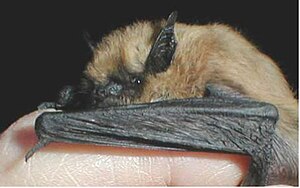Western little-footed mouse-ear
| Western little-footed mouse-ear | ||||||||||||
|---|---|---|---|---|---|---|---|---|---|---|---|---|

Western little-footed mouse-eared mouse ( Myotis ciliolabrum ) |
||||||||||||
| Systematics | ||||||||||||
|
||||||||||||
| Scientific name | ||||||||||||
| Myotis ciliolabrum | ||||||||||||
| ( Merriam , 1842) |
The western little-footed mouse- eared mouse ( Myotis ciliolabrum ) is a bat species from the smooth-nosed family (Vespertilionidae), which is native to North America. Until 2005 it was listed as a subspecies of the Eastern little-footed mouse-eared mouse ( Myotis leibii ).
The species name is composed of the Latin "cilium" (= eyelid) and "labrum" (= lip).
description
The western small-footed mouse-ear is a small mouse -ear with a forearm length of <34 mm and an average weight of 4.5 g . The females are slightly larger than the males. The black mask around the eyes, which contrasts with the otherwise light fur color, is characteristic. Such a mask is absent in sympatrically occurring California mouse ear ( Myotis californicus ), which generally has a dark coat color. The flight membrane , face, and ears of the Western Little Footed Mouse-eared Mouse are also dark. The species has small feet (<9 mm) that are less than half the length of the tibia but larger than those of the California mouse-eared mouse . The ears of the western small-footed mouse-ear are relatively long (11-16 mm), the tragus is slender and about half as long as the ear. The wingspan is an average of 242 mm.
Way of life
The western lesser-footed mouse-eared bat is a common bat in desert-like habitats, but is also found in forests. The species is like most bats nocturnal and feeds on insects, which they particularly small moths seems to prefer, however, Fly , Schnabelkerfen , caddis flies and beetles captured. The western little-footed mouse-eared mouse is a relatively slow, agile flier. Where the western little-footed mouse-eared mouse-eared species appear together with the Californian mouse-eared mouse- eared, the species forage in different areas: the western little-footed mouse-eared mouse-eared preferred rocky regions, while the Californian little-footed mouse-eared hunted over water. In this way, the two bat species avoid food competition. The echolocation calls vary from region to region between 40 and 62 kHz and are therefore inaudible to humans. During the day, Myotis ciliolabrum hangs in rock crevices, caves and tunnels, but the species has occasionally been found in abandoned swallow nests, in buildings and under the loose bark of a pine tree . The animals can be found individually or in small groups. During the cold season, the western little-footed mouse-eared hibernation in caves, crevices and abandoned mines. Even here you usually only find individual animals and not large groups. Other species of bats such as Corynorhinus townsendii and the great brown bat ( Eptesicus fuscus ) are sometimes found in the same hibernation areas . The females of the western little-footed mouse-eared mouse each give birth to a single young in spring. Newborns have a forearm length of approximately 12.4 mm and a weight of 1.1 g.
distribution and habitat
The western little-footed mouse-eared ear occurs in Canada in Alberta and Saskatchewan and south in the United States to Kansas and New Mexico . Thanks to its widespread distribution, the IUCN has classified its population as stable and the species as safe, but it is protected in the individual states.
literature
- GL Holloway, RMR Barclay (2001): Myotis ciliolabrum . In: Mammalian Species , No. 670, pp. 1-5